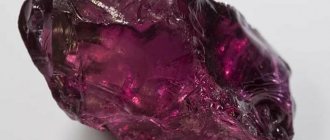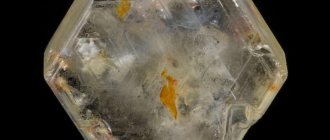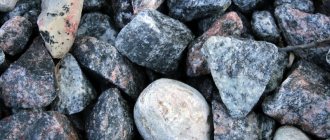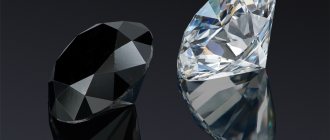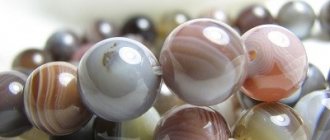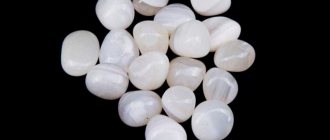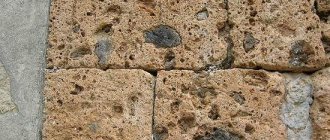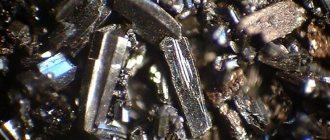CONTENT
- Assessing the color and quality of blue gemstones
- Blue gemstones perfect for everyday wear Sapphire
- Tourmaline (indigolite and paraiba)
- Aquamarine
- Spinel
- Turquoise
- Blue Diamond
- Chalcedony
- Eremeevit
- Dumortierite
- Sapphirine
- Hawk's eye
- Blue jadeite
- Tanzanite
- Moon rock
- Iolite
- Apatite
- Larimar
- Benitoite
- Zircon
- Lapis lazuli
- Topaz
- Opal
- Lazulite
- Grandidierite
- Blue akoya pearl
- Azurite
- Kyanite
- Labradorite
- Sodalite
- Sillimanite
- Shattuckite
- Smithsonite
- Vivianite
- Halite
- Hemimorphite
- Will speed up
- Cavansite
Blue is one of the rarest colors in nature.
However, blue stones are always in demand in jewelry. People have been adorning themselves with jewelry for centuries, but the quality and variety of stones available today is amazing. This ring features royal blue sapphires with an unenhanced center stone weighing over 3 carats and matching natural stones on the band. © Aharoni Jewelery
This article is about assessing the quality of blue gemstones, both popular and well-known types, as well as rare examples. Plus, you'll learn which stones work best for rings and other jewelry, and which ones should be kept in a collection for display only.
Why do you dream about blue stones?
Dream books associate shades of blue with high matters: spirituality, intuition, subconscious desire for the heavenly light.
General interpretation
According to Miller’s dream book, if you dreamed of blue stones, a white stripe will dominate your life:
- The situation will improve in all areas: personal life, business, health, making dreams come true. Especially if you dreamed that pebbles were given to a sleeping person.
- If in a dream the stones did not cause delight or other similar manifestations, you will soon have to choose from a list of possibilities.
If jewelry provokes panic, confusion, plans and hopes are not realized.
Type of stone
It’s wonderful when you were able to recognize the type of pebble you dreamed about:
- aquamarine - you are on the verge of successful endeavors or meetings with a soul mate;
- turquoise - the search for love will be successful, and love itself will be dizzying;
- sapphire – unexpected profit or spiritual “dividends”;
- topaz - a magician or witch lies dormant in you, you should study the secret sciences.
Sky blue star sapphire
In any case, a good sign is that the dreamed stones are solid, shiny, without cracks, chips, or cloudiness.
Decorations
If it is not possible to recognize a pebble, the type of jewelry matters:
- Ring. Passionate, mutual love will surge, the finale of which will be marriage. Perhaps this will be an old acquaintance whom you will appreciate in a new way. For a family man, a ring with a blue stone means a common project with his other half. If the ring is antique, there will be quick communication with future destiny. However, this love most likely will not be cloudless.
- A signet ring promises ease of communication with the opposite sex or a quick meeting with an old acquaintance who will become a friend.
If you found a ring in a butchered bird or fish in a dream, expect profit or good news from afar.
- Earrings. Receiving good news or implementing a personal business project. Especially if they are gold earrings. If they were given to a person, the problems are over, you can serenely enjoy life.
Lost an earring in a dream - there will be troubles in reality.
- Stones in a pendant foreshadow large expenses. If you buy it yourself, be smart about your purchases. But a pendant or pendant as a gift foreshadows the imminent realization of a dream.
Beads mean a series of pleasures, a brooch means an increase in life status.
Assessing the color and quality of blue gemstones
Gemologists evaluate color based on hue, hue, and saturation. Gemstones often have a secondary shade in addition to the primary one. Blue gemstones usually have secondary shades of green and purple. A pure blue hue is especially sought after, and when a stone deviates from it, it becomes less valuable. However, greenish-blue and violet-blue gemstones are quite attractive! Blue sapphires with slight purple undertones are still the best. Other gemstones, such as Paraiba tourmaline, typically have secondary green hues.
Like many blue gemstones, this Swiss blue topaz has a secondary green tint. © CustomMade
Blue hues reach their maximum saturation or intensity in mid-dark tones, around 85%. This is called the gamut limit. Vibrant saturation produces stunning color. Darker tones will appear inky or steely, while lighter tones will appear washed out or gray. However, beautiful blue gemstones come in a variety of shades, from sky blue to deep dark colors.
Few gemstones can match the depth of color of this Madagascar sapphire. © Earth's Treasury
The purity of blue gemstones is much less important than colorless ones. Because color can mask inclusions, it makes them less noticeable. However, avoid large inclusions or cracks as they can make the stone brittle. For light blue gemstones, a higher degree of purity is desirable. This will improve their appearance. Avoid dark inclusions, as they will be easily visible in a light-colored stone.
Aquamarines are light blue gemstones. A dark inclusion in such a precious stone will detract from its beauty. © CustomMade
Blue gemstones perfect for everyday wear
If you are looking for a blue gemstone for your ring, the following minerals are your best bet. Each of these stones scores at least 6.5 on the Mohs hardness scale, making them scratch resistant. Moreover, they are less likely to break if accidentally dropped or hit on a table. These durable blue gemstones are suitable for everyday wear, making them ideal for engagement rings. With regular cleaning, they will look as good as the day you bought them.
Sapphire
Blue sapphire is the most popular gemstone to cut. It can have very high saturation. Royal engagements have also made it one of the most sought after options for engagement rings. Sapphire can be any color except red (ruby), but its classic shades of blue to violet are the most famous. These shades arise from the trace amounts of titanium and iron in the crystal structure of the stone. Sapphires are often heat treated to improve their clarity and color.
If natural sapphires are not in your price range, consider lab-created stones. They have the same durability and beauty as natural stones, but cost much less.
Brilliant and vibrant, Montana sapphires typically have a secondary green tint, but this stone's lack of steely gray tint is exceptional. © Earth's Treasury
Tourmaline (indigolite and paraiba)
Tourmaline has recently become popular and expensive. Tourmalines come in all colors, but blue examples, called indigolites, are rare and highly prized. Due to its rarity, finished indigolite gemstones will contain inclusions and fractures more often than other colored tourmaline varieties.
Some Brazilian indicolites have an intense color known as "Mutaca blue". © Kat Florence
Most blue tourmalines contain tiny amounts of iron, which gives them their color. Some indigolites undergo heat treatment. This invisible process creates a lighter but more stable color.
Some indigolites contain copper. First discovered in Brazil in the 1980s, these stones were named Paraiba tourmaline after their place of origin. However, since then, miners have discovered copper-containing tourmalines in other parts of the world. Paraiba tourmalines have vibrant neon blue-green colors that wowed the jewelry industry when they first came to market. These gemstones are usually heat treated to enhance the color, and some even have increased clarity making them look like emeralds.
These Paraiba tourmalines come from the original vein of the Batalha mine. They are not improved by heat. The ring contains a stunning 4.15 carat stone and the pendant contains a 15 carat stone. © Shelly Sergent
Aquamarine
Aquamarine, known for its watery blues and blue-green hues, never reaches the dark tones and high saturation of sapphires and tourmalines. However, darker tones make more sense, even if the stone has a grayish tint. In the past, sailors wore this stone as a talisman.
Aquamarines are usually heat treated to reduce the green tones and produce a purer blue color. However, some stones are not changed by this treatment and remain an unusual but attractive seafoam blue-green color.
Antique pendants and ring with aquamarine. © The Parisian Flea of Hampden
Spinel
A favorite among gemologists, spinel is gradually gaining well-deserved recognition. This stone comes in a variety of colors, including blue. Although many stones are too dark to see color properly, mid-tones of intense saturation are beautiful. Cobalt-colored spinels are especially prized for their vibrant, rich blue color. Synthetic spinels, common and inexpensive, are often used as imitations for many gemstones.
Harry Tutunjian's Ocean Tides ring features a 15-carat cushion-cut blue spinel and colored wave-inspired sea glass. © Shelly Sergent
Turquoise
Widely found in both inexpensive jewelry and designer pieces, turquoise is the most popular of the blue gemstones. Its hardness varies from 3 to 7.5, depending on the mineralogy of the host rock. Thus, some types of turquoise are very scratch resistant, but most are easily damaged. Turquoise is a stone with ancient symbolism that is loved by many. However, low-grade turquoise is often stabilized or dyed to enhance the color. Some imitations are even sold as restored turquoise. The buyer needs to be careful.
Turquoise is often found in antique jewelry, such as this ring from around the 1870s. © The Parisian Flea of Hampden
Blue Diamond
Fancy blue diamonds are quite rare but have beautiful sparkle and dispersion, or fire. Although naturally colored gemstones rarely achieve high saturation, stones treated by irradiation and heat or through the HPHT process can have a vibrant color with some gray. Lab-created diamonds can also be blue.
This diamond has a beautiful color but contains many inclusions. 3 carats, princess cut. © R. Rothem Diamonds
Chalcedony
Excellent clarity and low cost have led to a resurgence in the popularity of chalcedony. Blue chalcedony, called chrysocolla, may have a secondary shade of gray or lavender. The new variety, painted with nickel and chrome, has vibrant blue-green hues. You will find it marketed as Aquapraz. Craftsmen often create cabochons or carvings from these stones to best showcase their color and clarity.
With its attractive blue-green color, aquapraz is making waves in the gemstone community. © Sam Woehrmann
Eremeevit
One of the rarest minerals in the world, eremeevite is found in only a few places. Jewelry-quality examples from Namibia have light aquamarine shades. Transparent crystals from other places are rare. Despite its rarity, eremeevite is cut. This stone has a hardness of 6.5 to 7.5 and is not prone to splintering. Eremeevite is durable enough to be worn regularly in jewelry.
A rare faceted example of Namibian eremeyevite. © DonGuennie
Dumortierite
If you want a piece of jewelry with a unique cabochon, dumortierite is a great option. This massive blue to violet-blue material is rare but can be quite beautiful. Its infrequent appearance in crystalline form means that only a few pieces can be cut. In some examples, dumortierite inclusions in quartz create fascinating structures reminiscent of a coral reef.
The fibrous dumortierite inclusions in this quartz cabochon appear like fireworks in the evening sky. Ring by designer Michael Endlich. © Pavé Fine Jewelry
Sapphirine
Named after the blue shades of sapphire, sapphirine can come in a variety of shades, from light to dark and from blue to blue-green. Fine cut crystals are rare and sought after by collectors. Some clear examples are found in Sri Lanka, but other places do not generally produce high quality blue gemstones. However, with a hardness of 7.5 and poor cleavage, this gemstone is durable and well suited for jewelry.
1.13 carat sapphirine. © D&J Rare Gems, Ltd
Hawk's eye
Watching a hawk's eye stone with a cat's eye effect is a pleasure. These stones are the blue version of the tiger's eye. While the iron turned the tiger's eye golden brown, the hawk's eye did not. The stone has a titanium blue color.
In this architectural ring from Metropolis Bolt Ring, the hawk's eye cabochon shows off a dramatic undulation. © Gina Pankowski
Blue jadeite
Blue jadeite, once a favorite of the ancient Mayans, is very rare. This stone, which is only mined in Guatemala, is often gray in color. However, jadeite is one of the hardest gemstones and is even known for its musical qualities. If you hit it with a hammer, it will ring like a bell.
Sky blue jadeite and rose quartz form a delicate combination. © La Casa del Jade
Assortment of minerals
The list of names of blue stones includes pure blue types and varieties of this shade in multi-colored minerals. There are types of blue stones, the shade of which is given by man.
Precious
According to the official jewelry classification, two stones are considered such.
Diamond
A diamond of these shades is the number one blue gemstone. Rarity of rarity: a pebble is found a year, and only in one place (South Africa). The price starts at $150 thousand per carat.
The Hope Diamond is a large diamond weighing 45.52 carats of deep sapphire blue color.
The most famous representative of the family is the legendary Hope Diamond . Its parameters are unique: 45.52 carats plus sapphire blue color depth. Plus an ominous aura: almost all of its owners died. The latter got rid of the stone almost 60 years ago, transferring it to the Museum of Natural History in the USA.
Sapphire
A blue variety of corundum. Viceroy of blue stones, one of the most beautiful in the segment.
The value is determined by the color. Cornflower blue, moderate intensity - a gemstone of the highest category, the most expensive. Too dark or too light specimens are several times cheaper. It is mined on almost all continents, but Sri Lanka produces the best jewelry raw materials.
Ring with Burmese sapphire
An attribute of the robes and headdresses of the highest hierarchs of the church and crowned heads.
Semi-precious
The most impressive and diverse segment:
- Aventurine. Standard shades are yellow-blue or reddish. The blue color of the mineral (like green) with sparkles is a rare exception. Blue aventurines are used only by jewelers.
Ring with blue aventurine - Aquamarine. A variety of beryl in blue shades: blue, cyan or blue-green mineral. The color depends on the amount of iron impurities. This is often the result of firing green or yellowish-green beryl.
Aquamarine pendant - Benitoite. A semi-precious stone that absorbs the energy of the Universe and transfers it to the owner. There are blue, violet, purple, light and dark blue stones. Benitoite
- Turquoise. Favorite stone of the East. The blue variety is the female version. A mandatory attribute of the wedding attire of Muslim brides. Brings positivity to life in all areas.
Turquoise - Jade. The standard color of the mineral is green. Blue specimens are rare, supplied only by Guatemala. Equated to precious. The variety of the mineral “Kingfisher jade” is distinguished by its bluish tint.
Beads with blue jadeite - Iolite A half or completely transparent mineral with a rich blue or violet color. The best natural imitation sapphire.
- Lapis lazuli. There are variations with colors ranging from violet-blue to greenish-blue and gray with a greenish tint. Most agglomerates are spotted or streaked. Lapis lazuli is supplied by Afghanistan, Russia, and the USA. Ring with lapis lazuli and hairy quartz
- Opal. Some varieties of this mineraloid have a blue tone or shades: jirasol is a transparent blue noble opal with the same opalescence; black – red-blue specimens of a dark purple or dark blue hue with bright red opalescence; Peruvian - opaque with a bluish-greenish pastel color. Jirasol and Peruvian opals are considered precious.
- Blue quartz. The second name is sapphire quartz. Quartz is one of the most common minerals used by jewelers and industrialists. But specimens of the blue variety are rare. This is a high-quality natural imitation of precious stones.
Blue quartz bracelet - Tanzanite. A blue variety of the mineral zoisite. A stone that changes color depending on impurities. There are blue (sapphire), blue-violet and purple-blue shades. High-quality processing makes tanzanite equal to first-level minerals. Production takes place in the only place on the planet - the African state of Tanzania.
Varieties of Tanzanite - Topaz London blue. London topaz is a variety obtained by irradiating pale blue topaz with neutrons to intensify the color. Scientists in London did this for the first time, creating a color reminiscent of the evening sky over Wales. Hence the name. The material is safe: the stones are kept in the laboratory until the radiation level decreases to normal values.
Pendant with London topaz – “Heart of the Ocean” - Tourmaline. Extraordinarily beautiful varieties of the mineral are blue elbaite and dark blue indigolite. Both are very fragile, so they cannot be inserted into rings or bracelets. They are processed in the likeness of a diamond, that is, brilliant cut.
Ring with blue Tourmaline - Zircon. The classic color of the mineral is straw-yellow; the blue variety is created by titanium impurities. It is rare and loved by jewelers. However, this is often the result of calcination of brown zircons.
- Spinel. Spinels of any color are rare and expensive, especially blue ones. Their coloring is multifaceted. There are dark, green, violet and black-blue versions of the mineral.
- Jasper. One of the most common gems. But blue or purple specimens are rare, which is why they are considered precious. A variety of jasper mixed with Prussian blue is called Swiss or German lapis. Used as an imitation of lapis lazuli.
Blue Jasper
High-quality semi-precious specimens are often comparable in price to precious stones.
Ornamental
The list of minerals is small:
- Onyx. In gemology, this is both a type of agate and an independent striped mineral. One of the banding options is blue and white. A rare blue variety is sapphirine. Used as an ornamental stone. It is used to make bracelets, beads, candelabra, and photo frames.
- Dumortierite. The mineral is mined in the USA, Europe (France, Czech Republic, Poland), and Madagascar. Brazil has transparent light blue samples. Used in the manufacture of premium quality porcelain, souvenirs, jewelry and as a collectible mineral. Dumortierite crystal
- Kyanite. The mineral is used as a raw material for industry (for example, for the production of refractories) and for decorative and ornamental purposes. Kyanites are simply blue, dark, green or violet blue. Jewelry is supplied by India, their ancient Russian name is bausy.
Kyanite bracelet - Azurite. Natural imitation of lapis lazuli. In jewelry, inserts are covered with silver mesh for safety. The “ancestor” of malachite, mined on all continents. Unusual specimens are sought after by collectors. Ring with azurite
The mentioned stones are classified as ornamental because of their prevalence or low cost. Their aesthetic standards are worthy.
Artificial
This segment contains minerals of different qualities:
- Cubic zirconia, moissanite. High-tech products, high-quality imitation diamonds, recognizable only on special equipment. Structurally and externally they copy the original, which is often complemented in decorations.
Ring with cubic zirconia - Alpanit. An artificial mineral with a glassy texture and a full range of blue shades. Used for jewelry, imitating natural stones. Variant of the name is alpinite.
Alpanite earrings
The quality of alpanites is average, unlike cubic zirconias or moissanites.
Magic
The famous magical artifact of this color is located in Russia. This is the Blue Stone on Lake Pleshcheyevo, in Pereslavl-Zalessky (Yaroslavl region). A cult object of pre-Christian times.
The blue stone (Sin-kamen) is a sacred stone near Lake Pleshcheyevo.
In its normal state, gray turns blue when wet. A similar effect is created by the refraction of light by small grains of quartz and biotite flakes that make up the stone.
It is believed that the Blue Stone is capable of fulfilling a cherished wish, but only when it is wet and blue.
Blue gemstones to wear on occasion
Unfortunately, not all blue gems are durable. Some are soft or may crack. The following gemstones are best suited for earrings, pendants and brooches. If you are creating a ring with one of these gemstones, use protective settings to minimize wear.
Tanzanite
The popularity of this stone, which is found only in a small area of Tanzania, has increased dramatically in recent years. The intense blues and purples produced by heat treatment imitate fine sapphire at a fraction of the cost. However, tanzanite can easily chip or break when struck against a surface. And yet this rare stone is an excellent alternative to sapphire.
This high quality tanzanite has a rich blue color with slight purple undertones. © Aharoni Jewellery.
Moon rock
This stone has an unusual luster called adularescence. In many specimens it appears as a blue cloud floating in milky white stone. The highest quality moonstone has a vibrant mid-blue color on a colorless body. Such stones are usually polished or carved into high domes. This variety of feldspar is quite soft and fragile, so store it separately from other stones.
Moonstone cabochons often have a high dome to best display adularescence. This ring features a large royal blue moonstone with diamond and sapphire accents. © The Gem Vault
Iolite
Although iolite never reaches the saturation of sapphire, it can serve as an excellent and inexpensive alternative. Due to low prices and the lack of known methods for processing it, some gemologists consider iolite to be an undervalued stone. It is remarkable to contemplate the intense pleochroism of this stone, which appears dark blue on one side and light yellow on the other. In addition, this mineral has historical significance. Some historians believe that iolite is a Viking sunstone that was used for navigation at sea. However, if not handled correctly, this stone can break.
This setting will protect the deep purple and blue iolite gemstone very well. © Aharoni Jewellery.
Apatite
The term "apatite" refers to the entire group of minerals. However, the name is often used to refer to apatite gemstones. Although these stones come in almost any color, the bright neon blue-green material from Brazil is especially impressive. Apatites are heat sensitive and fragile, so be careful when setting them into jewelry. Never clean them using mechanical or hot cleaning systems.
The vibrant blue-green hues in this Caribbean apatite sparkle like tropical waters. © Kat Florence
Larimar
In the Dominican Republic, a fibrous mineral called pectolite, a deep blue color, known as larimar, is found. Although this stone is quite durable, it is a 6 at best on the Mohs hardness scale, making it prone to scratches. Larimar is a rare gem. It makes a great souvenir and unique gift for gemstone collectors.
Pendant with a large dreamy sky blue piece of larimar that is adorned with a tanzanite inlay. © Market Square Jewelers
Benitoite
If a blue diamond is not in your price range, consider benitoite. This gemstone has greater variance than diamond, and despite its rarity, it is cheaper! The unique Californian stone attracts attention with its deep blue color and bright fire. However, a hardness of 6.0–6.5 may cause scratches over time. Use protective settings for jewelry with this fragile blue stone.
This 2.40 carat benitoite has some imperfections, but its violet-blue color hides them well. © Earth's Treasury
Zircon
Another underrated gemstone is zircon. It has dazzling brilliance and fire. It is often confused with cubic zirconia, a synthetic material, so buyers may not pay attention to it. However, the bright blue hues of this stone are attractive and often have a strong green component. Although zircon can crack, its beautiful luster makes it an interesting and affordable choice for jewelry.
Properly cut zircon gemstones have a brilliance that few gemstones can match. © Pebble Sprout
Lapis lazuli
With thousands of years of history and vibrant shades of blue, lapis lazuli is one of the most popular blue gemstones. Although lapis lazuli is prone to scratches, it is durable and, due to its abundance and low cost, can be easily replaced if damaged. While much of the world prefers solid blue stones, some American connoisseurs prefer small amounts of pyrite inclusions that appear in the deep blue stone like stars in the night sky.
The small amount of pyrite in this piece of lapis lazuli gives the stone a cosmic appearance. Transformable necklace. © Gina Pankowski
Topaz
This stone is known for its reddish and yellow hues, but with the advent of irradiation and heat treatment, inexpensive and attractive blue topazes have emerged. The treatment ensures that the color of the gemstones is permanent and remains completely safe to wear. Although topaz is quite fragile, proper cutting angles should reduce this risk.
Several trade names describe the color of topaz. This gemstone is London Blue, darker in tone than Swiss Blue and Sky Blue, and has a strong secondary green tint. © Pebble Sprout
Opal
In its class, this mineral is one of the most attractive gemstones. Opal is often mentioned in folklore. In blue tones, the play of color of precious opal can resemble sunlight on the surface of the ocean. Even an ordinary stone in blue shades is quite attractive. However, these stones are soft and may become scratched when worn openly in jewelry. Additionally, opals from some mines may crack as they dry. Coating the opal with a hard top layer will protect it from scratches, and proper care will go a long way in preserving the beauty of your gemstone.
The green swirls in this deep blue opal fit perfectly into the nature-inspired design of this Michael Endlich pendant. © Pavé Fine Jewelry
Lazulite
Although faceted lazulite is very rare and too fragile for jewelry, cabochons made from solid material are more durable. Lazulite, often mistaken for other blue gemstones, is difficult to identify and cut. However, this gemstone comes in attractive blue hues and could be a great addition to a collection.
Dark lazulite weighing 1.53 carats. © D&J Rare Gems, Ltd
Grandidierite
Weighing over 2 carats, gem quality grandidierite is one of the rarest gemstones in the world. Although most examples of this gemstone are translucent, a discovery in Madagascar in 2016 brings a more transparent material to market. This blue-green stone is scratch resistant but may break if bumped or accidentally dropped. Given its extreme rarity and high price, replacing such a stone will not be an easy task.
Weighing over 1 carat and internally flawless, this faceted piece of grandidierite is truly a rarity. © JL White Fine Gemstones
Blue akoya pearl
When most people think of pearls, they think of a white or ivory colored gemstone. Meanwhile, in recent years, many fans of rare blue pearls have appeared. These gemstones have a blue tint but the same coveted sparkle as white Akoya pearls. In addition, they are much less common. Today's consumers are looking for something natural, but not as conventional as a string of white pearls. However, any pearl is a soft gemstone and requires special care.
Strands of Baroque blue Akoya pearls with very high luster. © Pearls of Joy
Azurite
Azurite's vibrant blue colors make it popular among collectors and hobbyists. The gemstone, which is often confused with lapis lazuli, is often mixed with malachite and the material is cut into opaque blue and green cabochons. Faceted crystal material is rare, and faceted gemstones over a carat will be too dark. However, the rich color works well with cabochons. As with any soft material, store azurite jewelry separately from hard stones.
Azurite cabochons can add bold color to jewelry like these earrings. © Deidre Woollard
Kyanite
Kyanite is an unusual gem. Its hardness ranges from 4 to 7.5 on the Mohs scale, depending on the axis of the crystal. The stone is grayish-blue in color and usually contains inclusions. However, some craftsmen have managed to cut kyanite, despite its tendency to split and high fragility.
The kyanite cabochons in these Kyanite Comet Earrings feature attractive, silky inclusions. © Gina Pankowski
Labradorite
Some examples of labradorite feldspar exhibit a stunning blue luster when properly processed. This effect, called labradorescence, occurs due to paired mineral planes. When this phenomenon covers the entire stone, the result is impressive. With its low cost and relative abundance, labradorite can be part of any gemstone collection.
With a bright and uniform luster, this labradorite is sure to be admired. Paraiba tourmaline adds sparkle and complements the color of labradorite. © The Gem Vault
Sodalite
Sodalite is another opaque blue stone for jewelry. Cutters often make cabochons and beads from this material, and also carve images on it. Sodalite, which is part of lapis lazuli, has long been valued for its beautiful color. However, it remains inexpensive even in larger sizes. With a relatively low hardness, it can be scratched easily but is unlikely to break.
Sodalite beads add matching color to this mermaid necklace. © Laurel Moon Jewelry
Sillimanite
This stone is sometimes called fibrolite. Sillimanite occurs in a fibrous form, in which case it can contain beautiful crystals. Although this material is quite hard (6.5–7.5), it is brittle and can easily chip or break. Cutting sillimanite is a challenging task for cutters, and using it in jewelry is a risky choice. Although sillimanite is more often found as a pale yellow stone, it can have pale blue hues, like light aquamarine. Most dark blue specimens are artificially colored.
The cocktail ring features a light blue sillimanite weighing 3.1 carats. © Market Square Jewelers
Shattuckite
First discovered in the Shattuck Mine in Bisbee, Arizona, this copper silicate often has colors similar to turquoise. The mineral rarely grows in the form of large crystals. Instead, it is often formed through pseudomorphosis from malachite. Although shattuckite is soft and brittle on its own, it is often found mixed with quartz in massive deposits. When this happens, the resulting gemstone material, which is bright blue and blue-green in color, is strong enough to be worn.
The blue and blue-green swirls in this Shattuckite ring from Leslie Zemenek are mesmerizing. © RiverSea Gallery
In silver
The uniqueness of blue stones is that they look wonderful in both gold and silver rings.
Turquoise
There is an unusual semi-precious crystal in nature - turquoise. It delights ladies with its matte finish and the whimsicality of intertwined patterns and intricate patterns.
This stone was widely used in Ancient Egypt. It was he who, in combination with gold, decorated the sarcophagi of the majestic pharaohs.
This mineral is opaque and has a dense structure. That is why complex figures are so often cut out of it for crafts, souvenirs and jewelry. But turquoise is no less beautiful as a decoration for a silver ring.
The shade of this gem varies from azure to deep blue-green.
Zircon
One of the oldest crystals.
Zircon comes in a huge variety of colors in nature. In jewelry, the most valuable is transparent zircon, which exactly imitates diamond. Blue shades of zircon are replacing sapphires and topazes in silver rings.
Zircon has a lower cost than its “doubles”, which is why it is in demand for making budget jewelry. A silver ring with a blue zircon stone costs no more than 6,000 rubles.
With the discovery of artificial cubic zirconia, which has similar properties and an even lower price, the use of zircon is no longer necessary.
Chalcedony
This semi-precious mineral is named after the small town of Chalcedony in Turkey.
It has a delicate sky blue color and goes perfectly with the noble shine of silver. The most valuable variety of chalcedony is moonstone. This is a matte milky blue mineral that is perfect for young ladies.
Reference! A silver ring with a moonstone is quite inexpensive.
What is a bracelet with a ring on a chain called?
Should wedding rings be the same?
Blue Gems for Collectibles
Some gemstones are best used for display purposes only, as they are susceptible to impacts and scratches. While these blue gemstones may not be suitable for jewelry, they will add color and interest to a collection.
Smithsonite
Smithsonite, or zinc spar (zinc carbonate), is both brittle and soft. However, cut stone can have impressive dispersion. This fire makes it desirable for gem lovers. Although Smithsonite comes in a variety of colors, the blue to blue-green material is a favorite among mineral collectors.
Blue, striped and opaque smithsonite cabochons on display at the Mineralogical Museum, Bonn, Germany. © Ra'ike
Vivianite
Vivianite is so soft that you can scratch it with your fingernail! In addition, this mineral darkens in light. Most specimens emerge from the ground colorless or have a pale green tint. Over time they may turn dark blue. Despite the problems associated with vivianite, several specialists were able to cut this stone.
How long were the vivianite cabochons exposed to light? © Brittany Tucker
Halite
This may be the most delicious gem ever. Halite is the mineral term for sodium chloride, more commonly known as salt. Defects in the crystal lattice can give it unusual colors: royal blue or purple. Mineral collectors are looking for the perfect cubic crystals. Due to its solubility, brittleness, perfect three-way splitting and low hardness, this stone is almost impossible to cut.
The deep blue hues and cubic shape make blue halite a wonderful addition to any collection. © Rob Lavinsky
Hemimorphite
This zinc silicate mineral can range in color from pale to deep blue. Crystalline hemimorphite is rare, but there are cabochons of massive specimens. Some mineral samples have the appearance of microcrystals. In addition, several large crystals were mined and then cut. However, this stone is fragile and soft, so any stones are suitable for the collection.
Blue and vibrant hemimorphite like this example from China is perfect for any collection. © James St. John
Will speed up
This iron arsenate is soft and quite brittle, making it unsuitable for wearing in jewelry. However, the main reason not to use scorodite in jewelry is its arsenic content. Although scorodite is not very toxic in its mineral state, exposure of this stone to water (such as sweat) can cause arsenic to leach away. Crystals large enough to be cut do occur, although they are rare. However, some artisans have used their skills to demonstrate the blue colors of this dangerous mineral. If you decide to cut scorodite, take precautions. Avoid breathing dust or fumes and wash your hands thoroughly.
Precious scorodite specimens from Tsumeb, Namibia. © Rob Lavinsky
Cavansite
Cavansite crystals, which are most commonly found in Pune, India, can have a beautiful blue hue. However, specimens large and transparent enough for cutting are extremely rare. Sometimes druse or massive cavansite is worn as decoration, but these stones are soft and fragile.
Bright greenish-blue crystals of cavansite on stilbite from the Pune region, India. © Géry Parent
Based on an article from the website https://www.gemsociety.org/article/blue-gemstones/


